The Birds of Spring
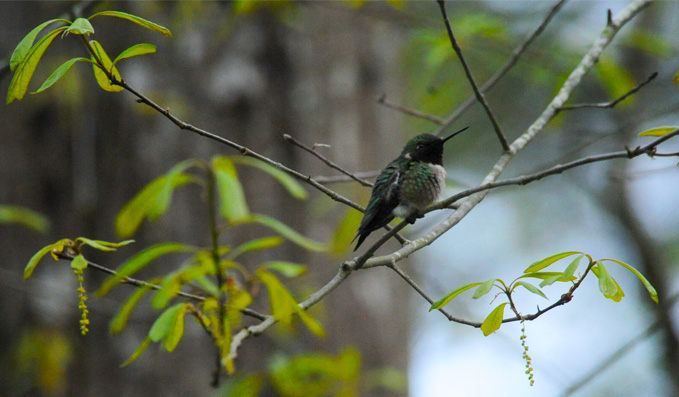 | With a cold February and March, these leaves did not come out until close to April 1. Here on April 9 the oak leaves are still young and the hummingbird just arrived about April 5. We noticed him on the azaleas and promptly put out our red hummingbird feeder. |
Our old friend the titmouse stayed with us through the winter, but it was a treat to see it among the new oak leaves. | 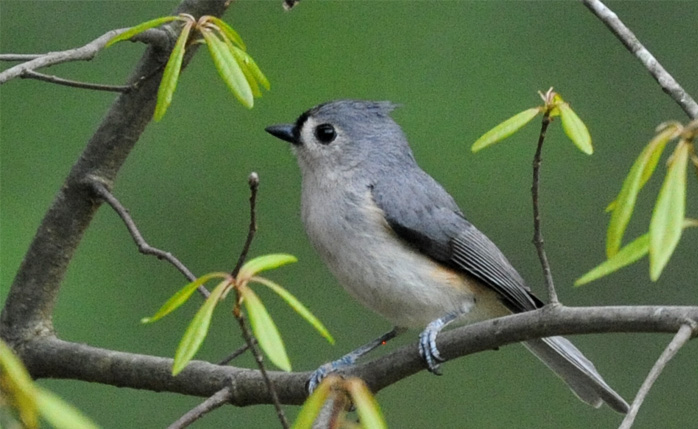 |
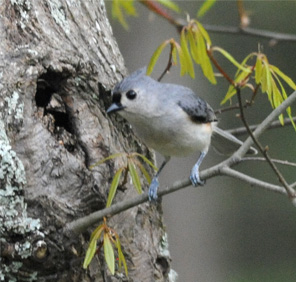 Our breakfast table view this morning included the titmouse preparing for a swoop down for a peanut from the feeder attached to the window. Then there was the drama of Marty's cat hopefully stalking a squirrel that was above, shaking his tail at the cat. The cat is a regular visitor, and we look out to see three or four squirrels a short distance up the trees, shaking their tails in warning that the cat is present. No doubt they are also cussing the cat! | 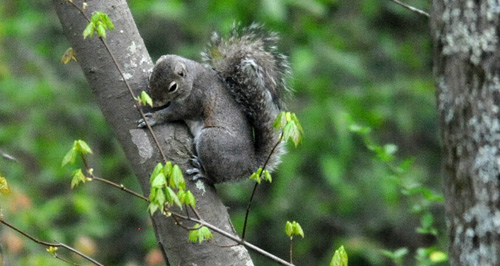 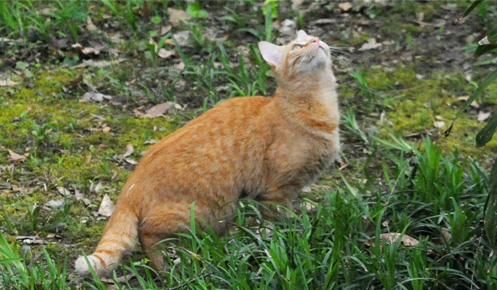 |
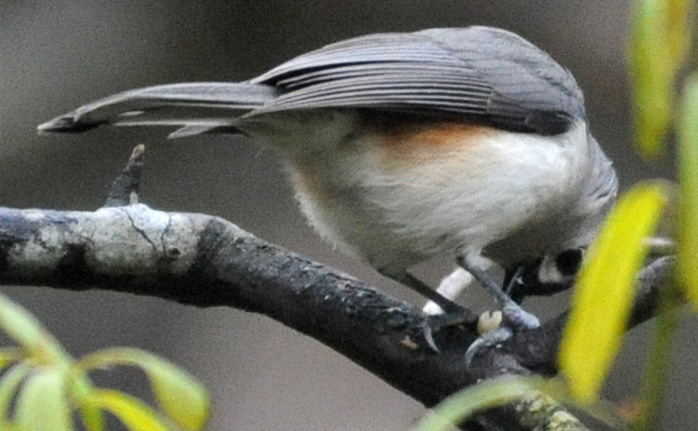 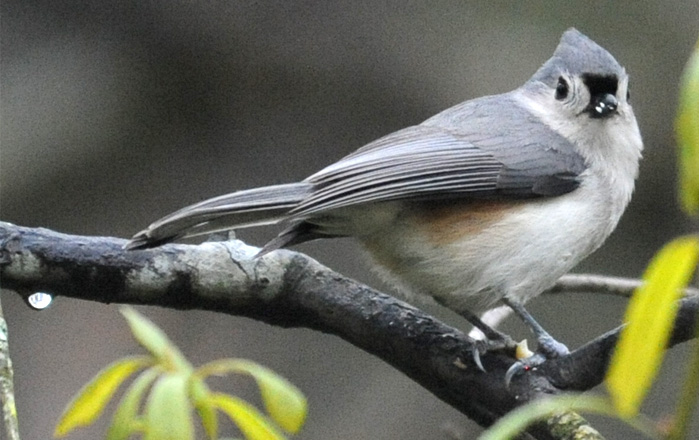 | Having fetched a peanut from the feeder on this damp morning, the titmouse carries it up to an oak tree limb to eat it. He holds the peanut in one claw and pecks on it. But every two or three pecks he raises his head to do his security routine. |
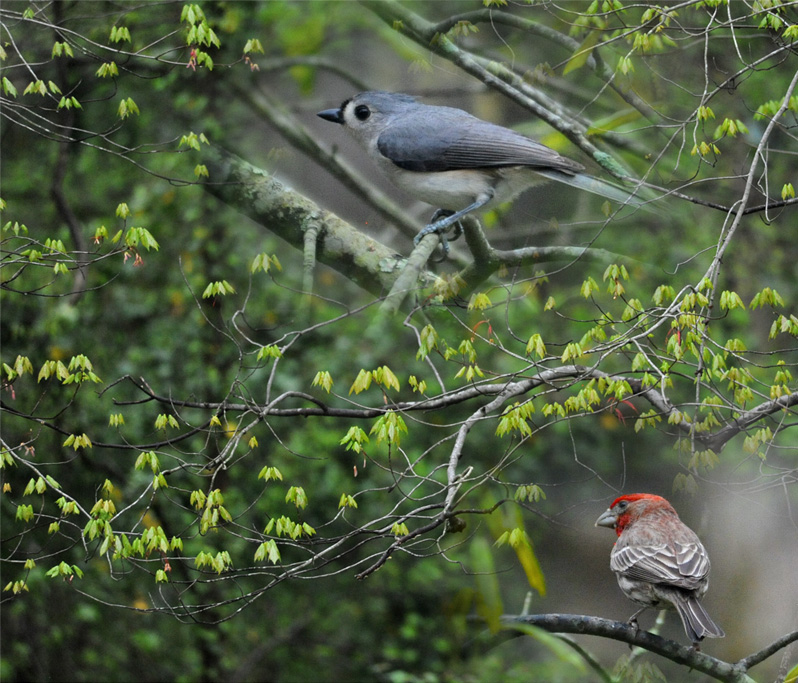
We had very much looked forward to the coming out of the new green leaves on the trees in view of our breakfast table. Now we could enjoy the view of the birds among that lush green. The titmouse and house finch were two of our familiar friends.
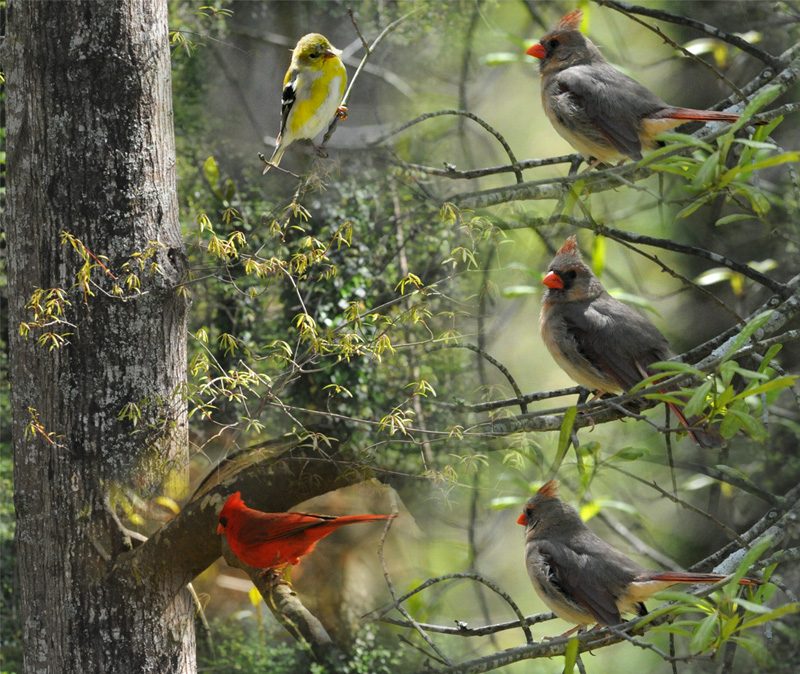
On April 10-11 we were visited by the male and female cardinals, who seem right at home this year. There are also a number of the small pine warblers.
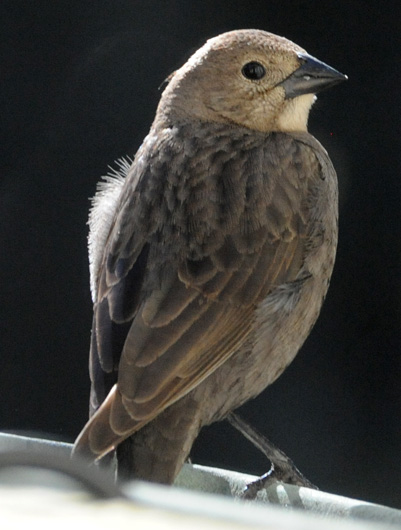 | 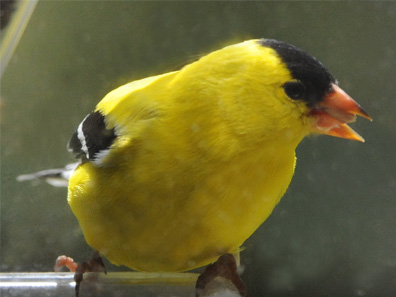 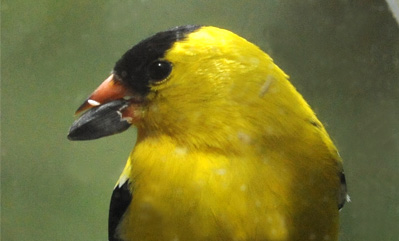 |
I much prefer maintaining my "wilderness illusion" with nothing manmade in the frame, but sometimes the pictures you can get are on the feeders. I believe the bird at left is an ordinary brown house finch, but they come in a lot of color variations. It may be a juvenile - doesn't exactly look like the ordinary member of our "finch mob". The goldfinch on the right is showing that he can shuck the sunflower seeds just like the house finches can.
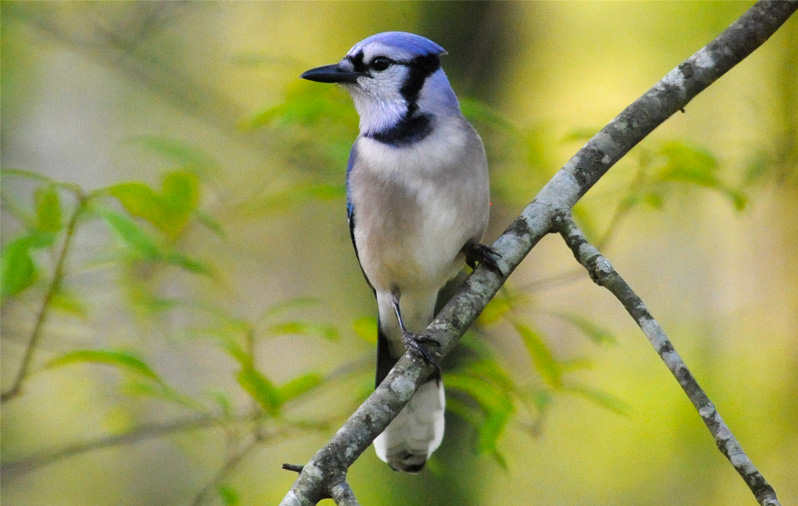
On April 13 this fine speciment of a bluejay visited us. Mostly it has just been this one, but on a few occasions there have been two of them.
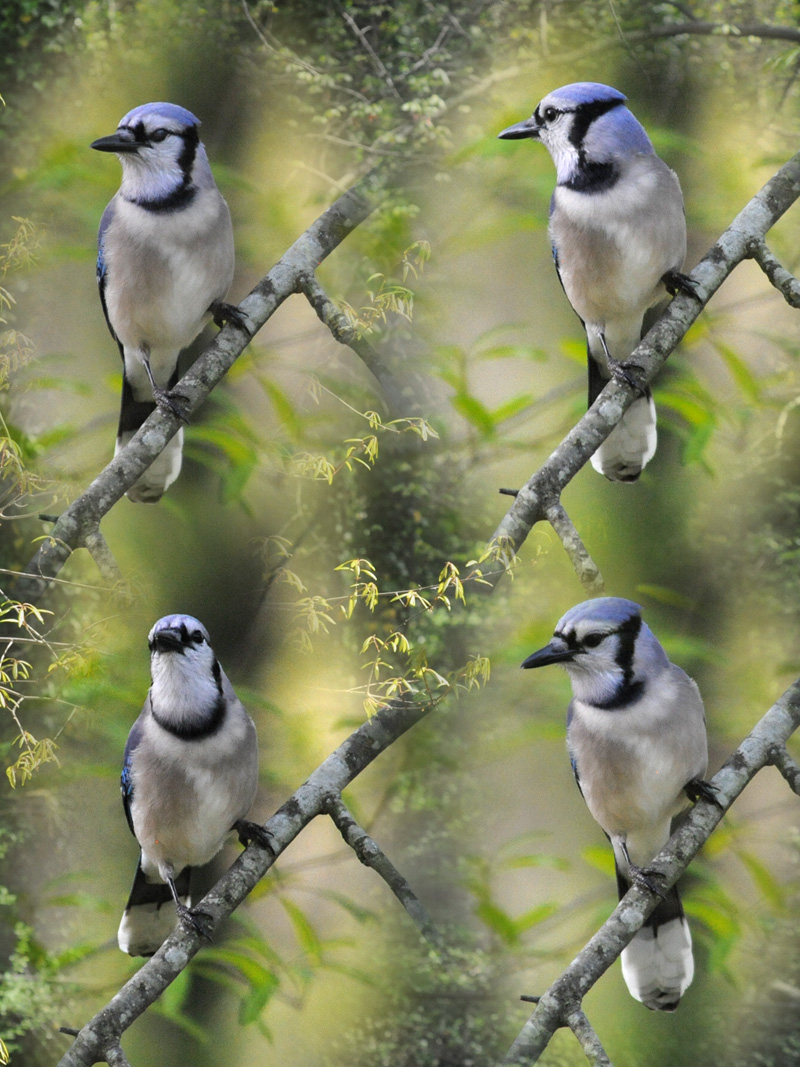
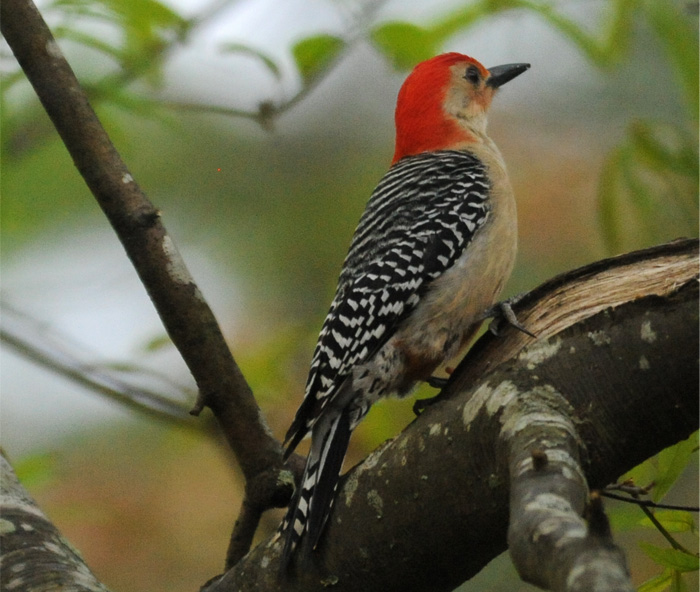 | Our morning treat on April 14 was the redhead, who was coming to the peanut feeder and taking peanuts up to a limb that was in clear view of our breakfast table. This is more formally the yellow-bellied sapsucker or the red-bellied sapsucker, but "redhead" is our common monicker. |
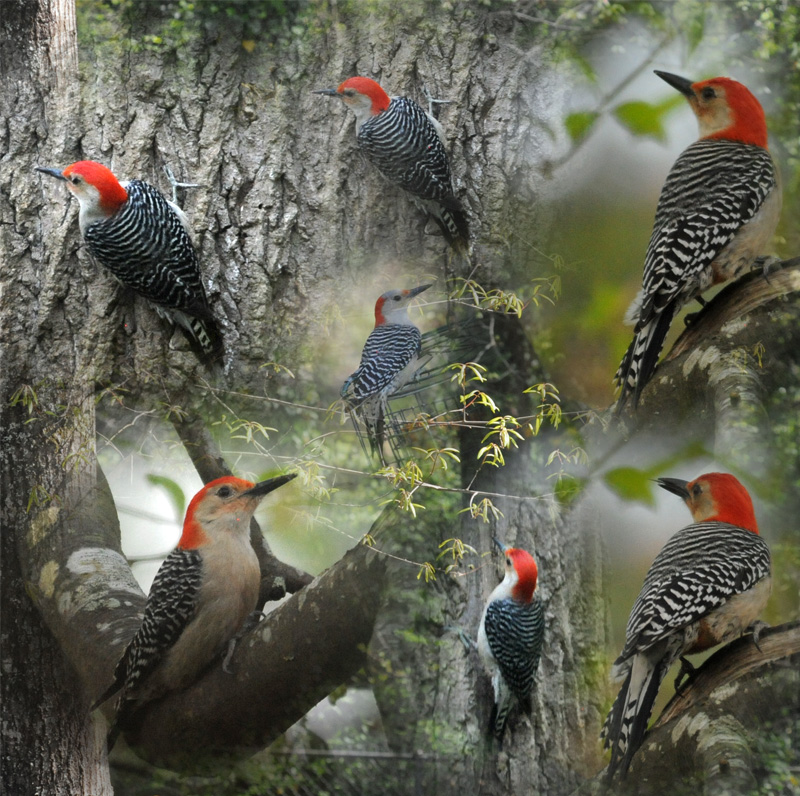
It is always a treat to watch the redhead. He comes in on the suet feeder regularly and scatters all the smaller birds. He has an exuberant "chirp" as a regular call, and then when I am out in the yard I get a different chirp like "What are you doing in my yard?!" We often see him storing seeds in the bark crevices. The one at center above has a different pattern on its head.
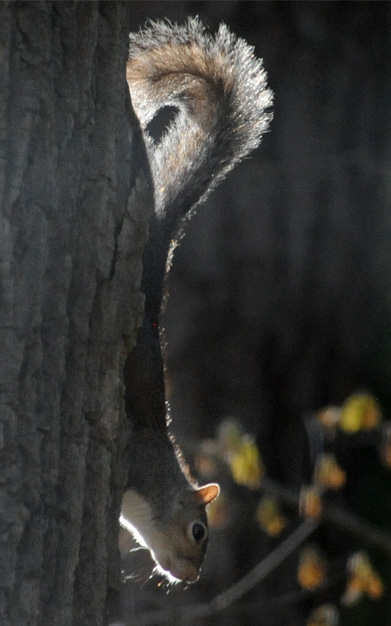 | 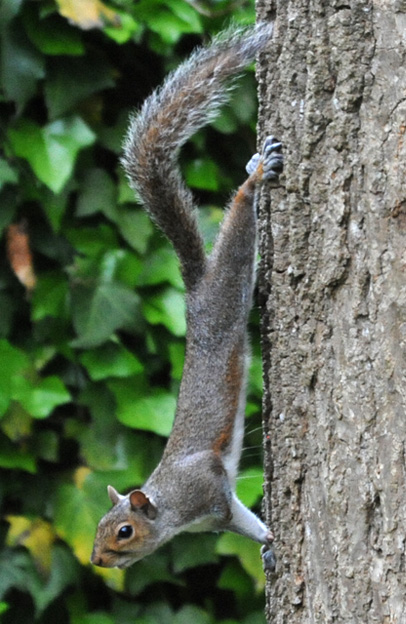 |
Although we fuss at them and joke about them, the squirrels are part of the morning entertainment as well. Their incredible aerial acrobatics never cease to amaze.
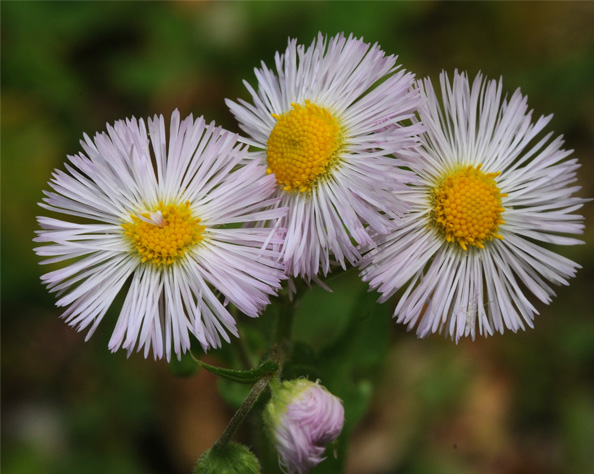 | 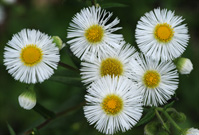 This is also the time for the wildflowers in the yard like this daisy fleabane to be in full bloom. |
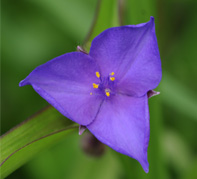 The spiderwort that we got from Aunt Dorothy is not exactly a wildflower, but it is spreading like one. We enjoy that color at this time of year. | 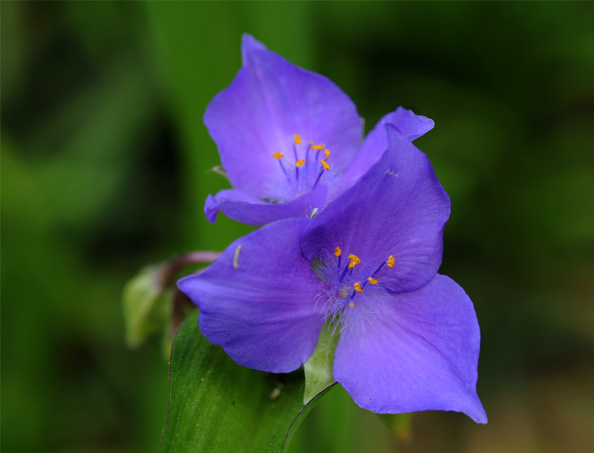 |
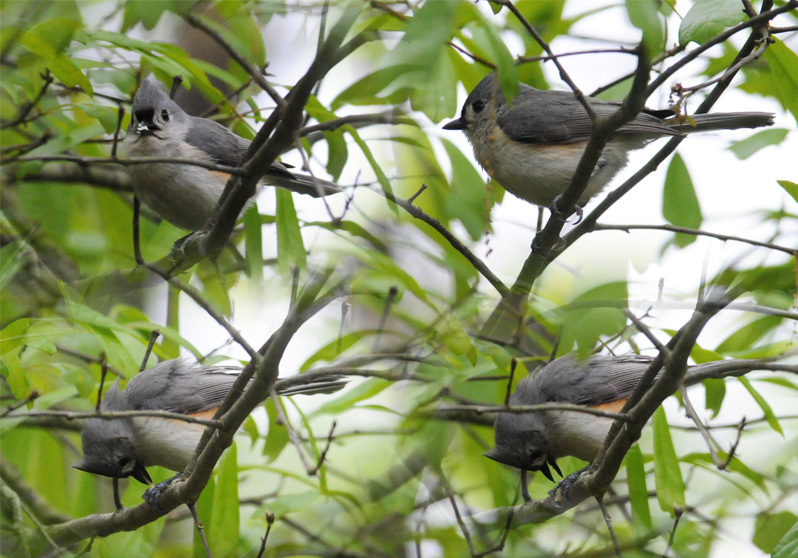
On April 16 we had another opportunity to watch a titmouse feed on a peanut. They are amazing flyers, like little fighter aircraft maneuvering around to land and get a peanut. But their feeding process is laborious - hold the peanut on a limb with one claw and peck on it.

We got to see quite a variety of birds on this morning, the brightest being the goldfinch. A couple of them had been around for a few days, but this was the first photo opportunity I had. On bottom left above is a pine warbler. The two different bluejays show some of the variations of those birds.
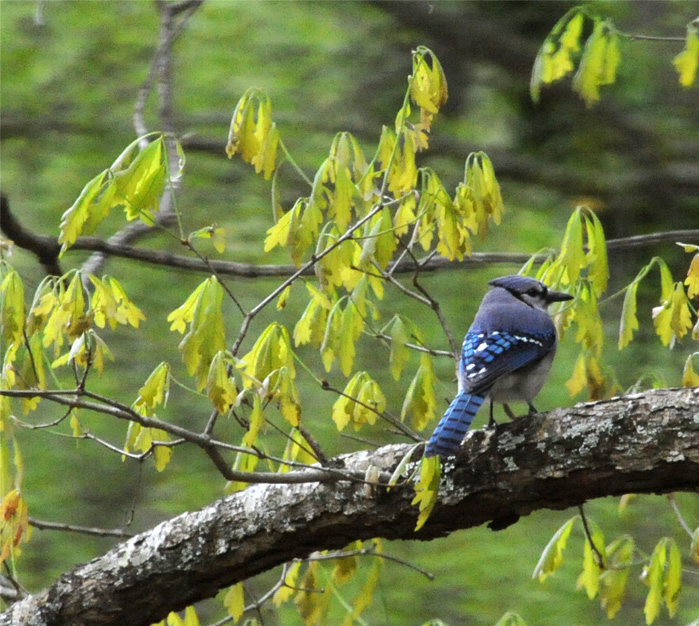 | I liked the new leaves, showing the stage of emergence of these large oak leaves. The smaller leaves of the pin oak shown in some of the photos above had already about reached full size. |
Part of the daily adventure is Marty's cat coming up to stalk the squirrels and birds. The squirrels run up trees and switch their tails to warn everything else of the cat's presence. The cat may have caught something, but we haven't been witness to it. | 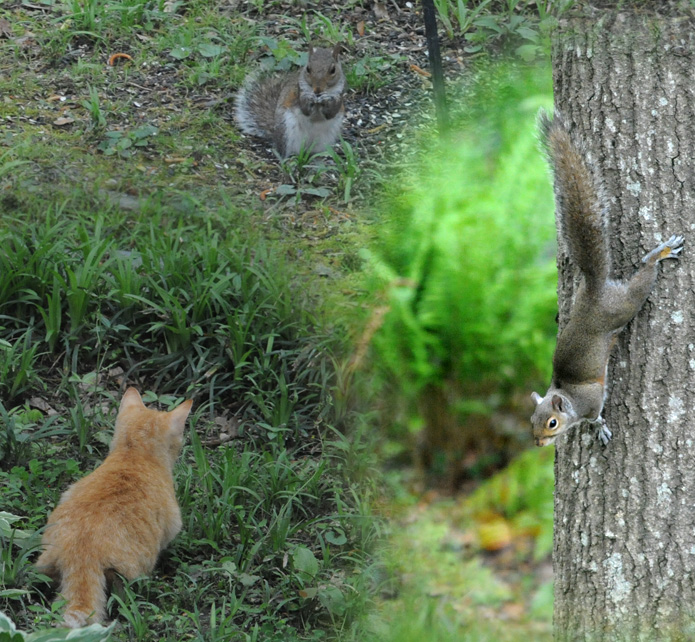 |
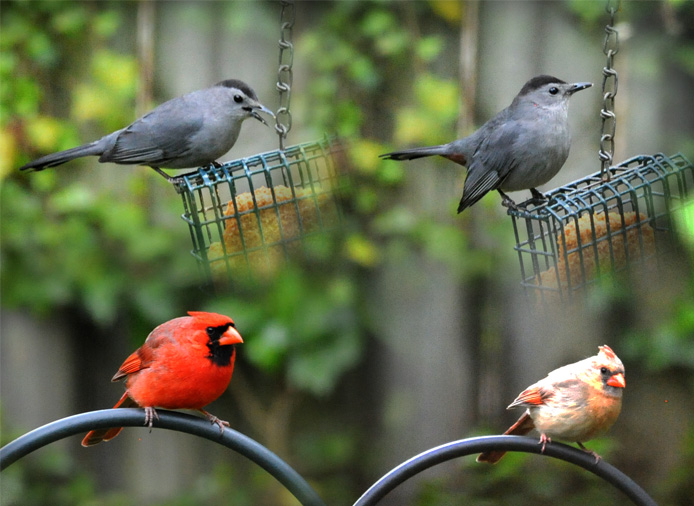 | Several cardinals have been around for weeks, but the pair of catbirds just showed up a few days ago. |
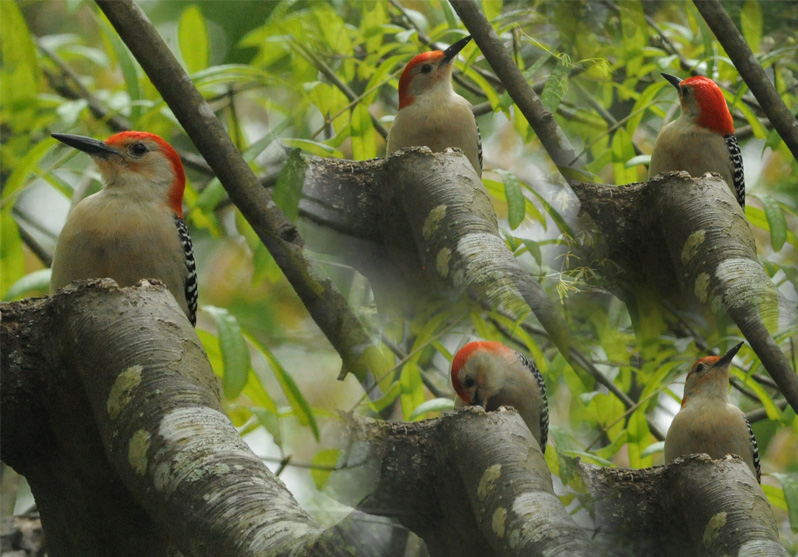
The redhead (a.k.a. yellow-bellied sapsucker) came back today and is again showing a taste for peanuts. He gathers three or four peanuts from the window feeder and takes them up to a spot in an oak tree to place them for eating. He has an elaborate security routine, looking all around after every couple of pecks on the peanuts.
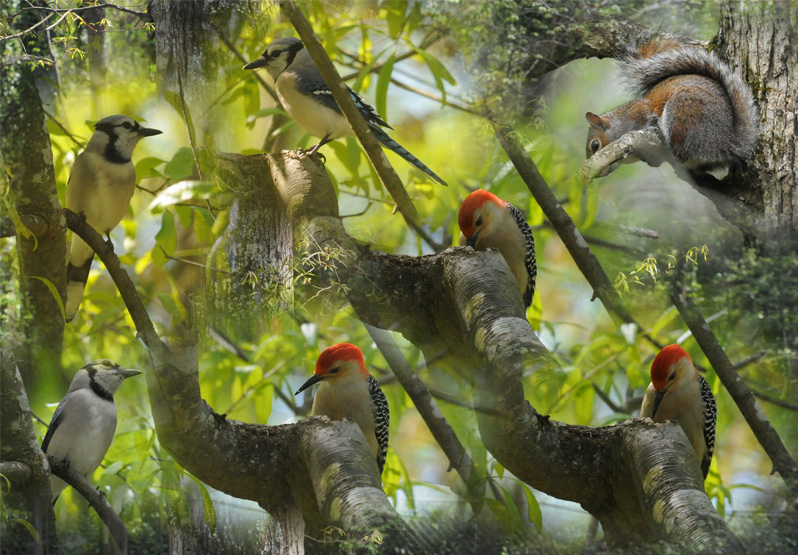
April 17 was another active morning in the back yard. The bluejay and the redhead are liking the peanuts, and the squirrel will take anything he can get.
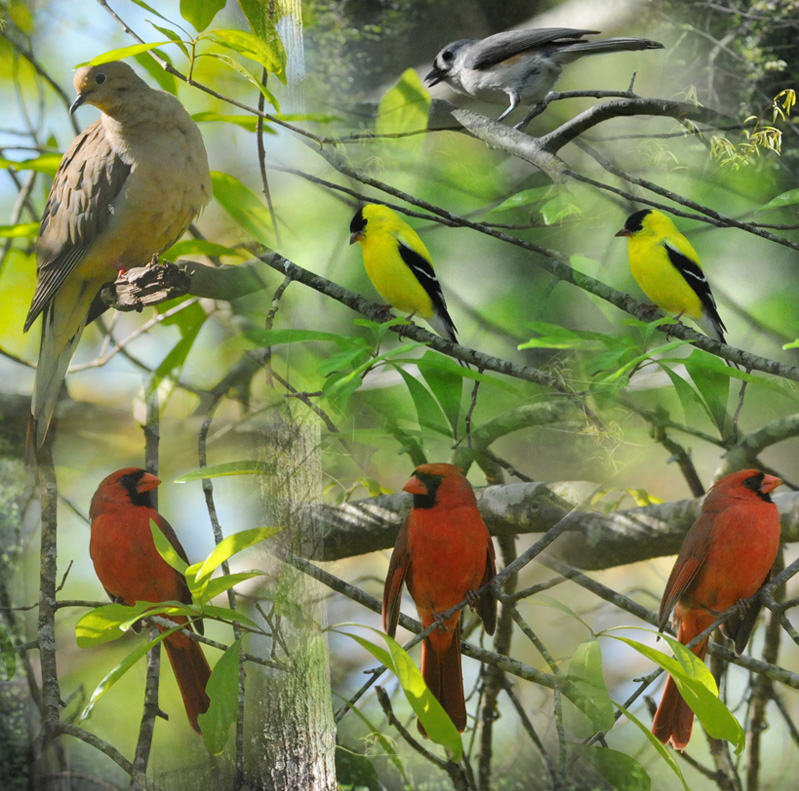
These were some of our breakfast companions on April 18. The titmouse and cardinal are daily visitors. These were good views of the nice goldfinch. The doves, usually a pair, are occasional visitors.
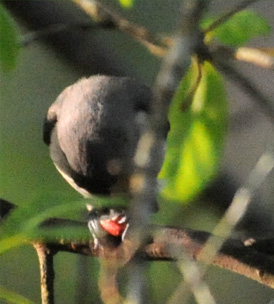 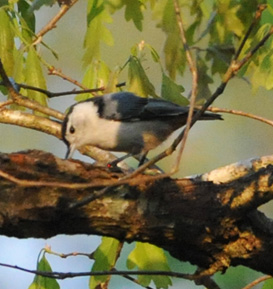 | April 19 was a time for mostly old friends. This early cardinal was up in the middle of the new leaves and looked like he was surrounded by a green glow. 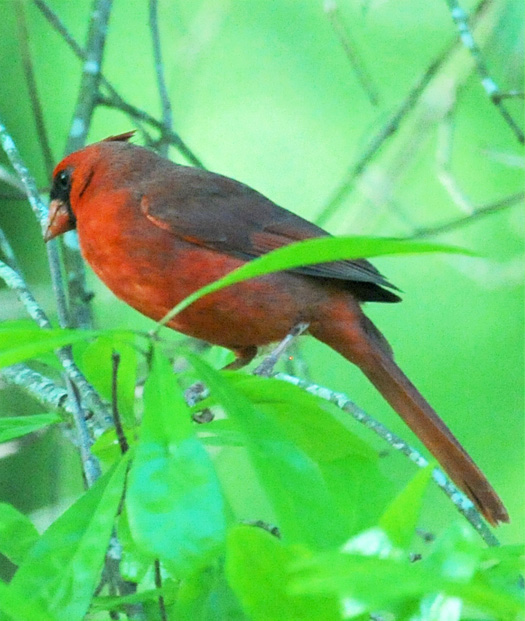 |
On April 21 at breakfast we were treated to the view of this lovely female cardinal in the glowing new leaves.
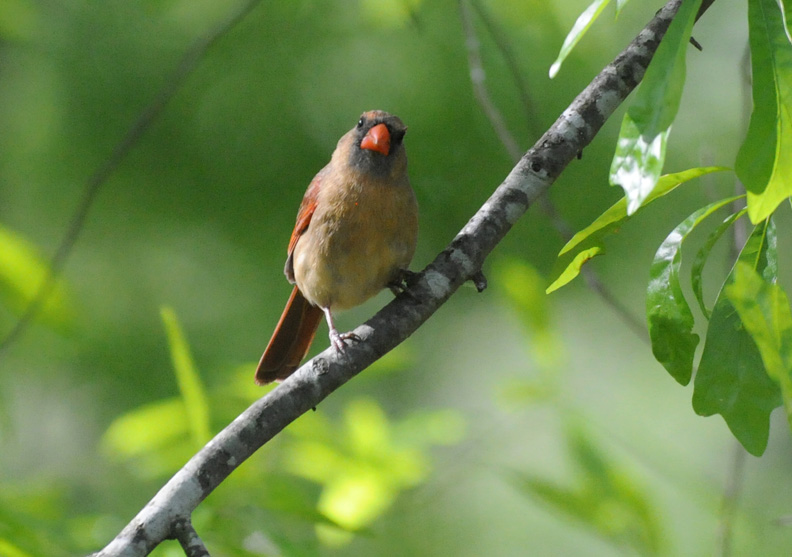
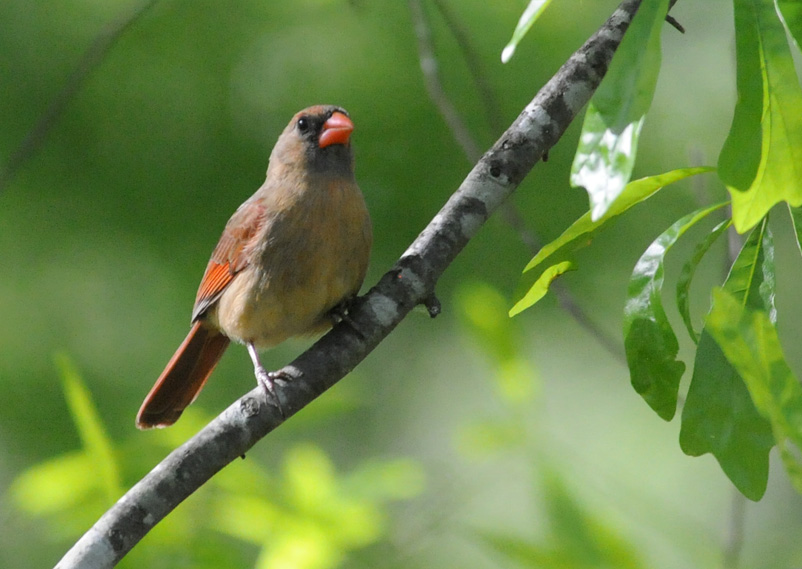
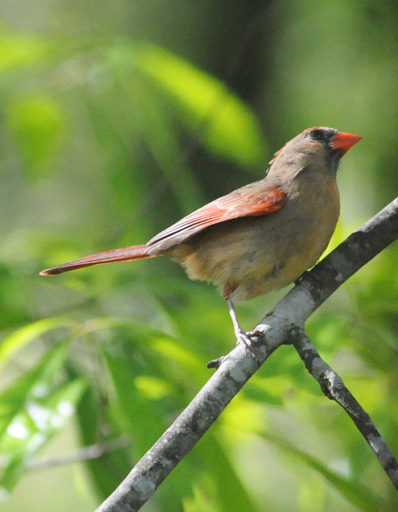 | 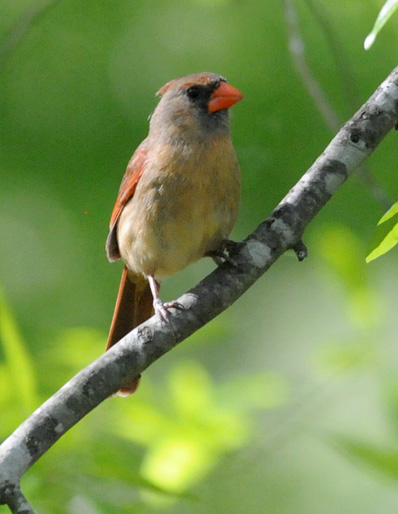 |
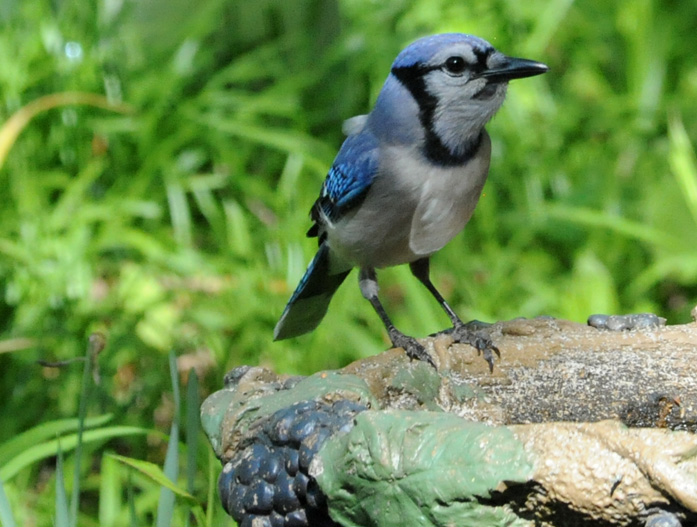 | The bluejay adds some color to the scene when he arrives for a drink at the birdbath. |
On April 23 we got a rare visit from a rose-breasted grosbeak. I felt bad that we hadn't prepared a more royal welcome for him. There was just a scrap of suet left. We had seen a lady grosbeak in 2016 and the male in 2015. I had also seen a yellow grosbeak in Ecuador in 2015. 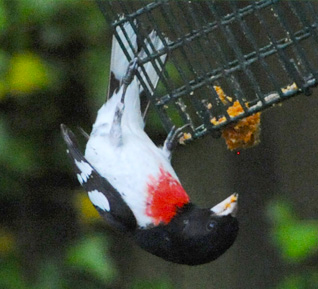 | 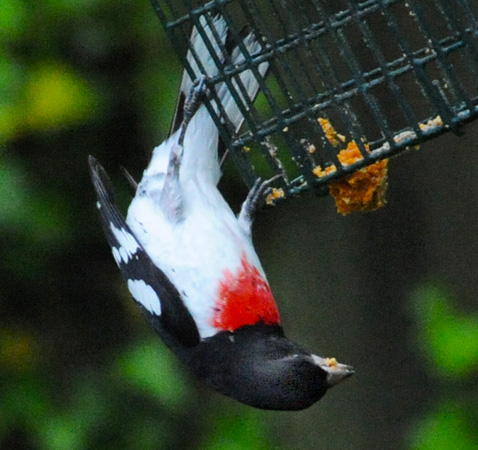 |
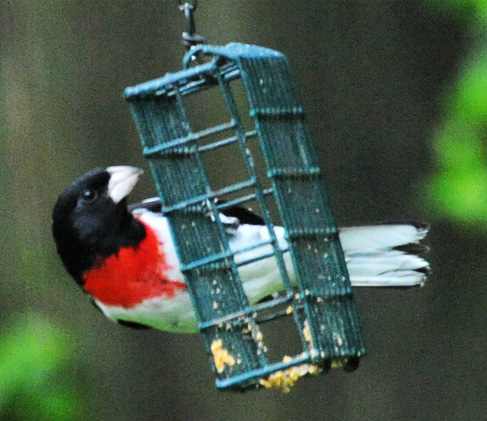 | He came back again, but the cupboard was bare. 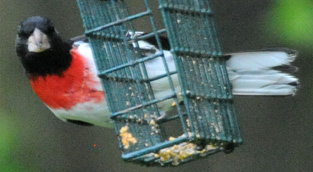 Hey! Where's my lunch?! |
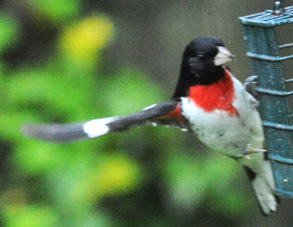 | The takeoff shot at left shows that there is a rose patch under his wing as well as on his breast. | 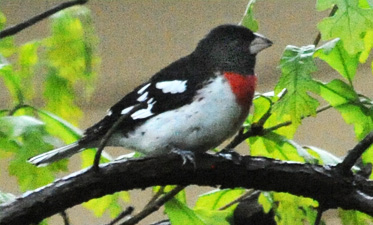 |
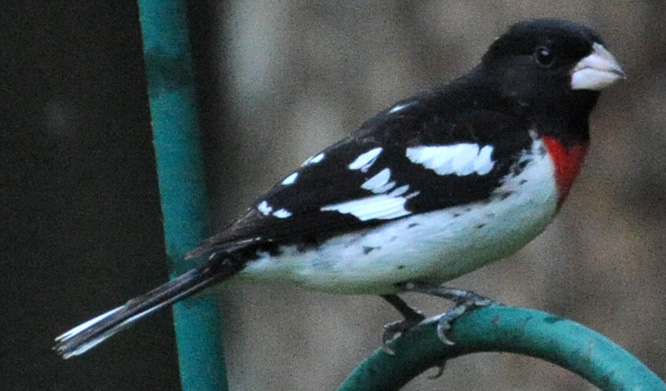 | This was about as detailed a shot as I got. It was hard to get much detail in that black head. |
We have enjoyed the catbird pair. We have seen the pair together on the birdbath several times. We are also enjoying the regular presence of perhaps five cardinals, three males and two females. They give us enjoyable color in both the early morning and late afternoon. | 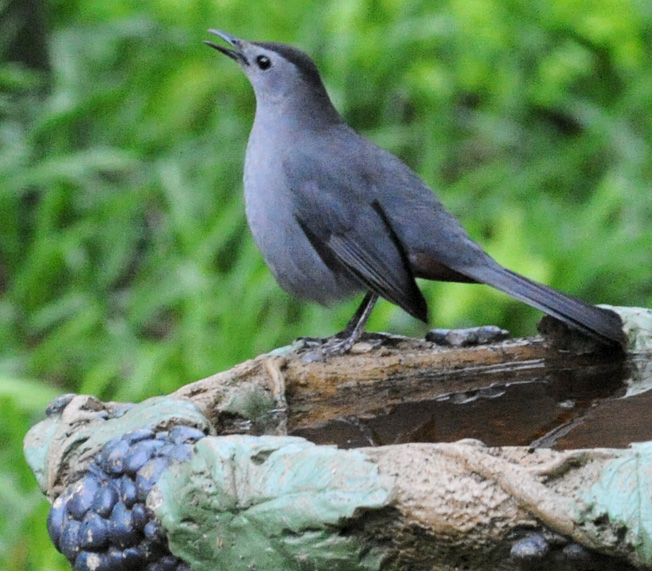 |
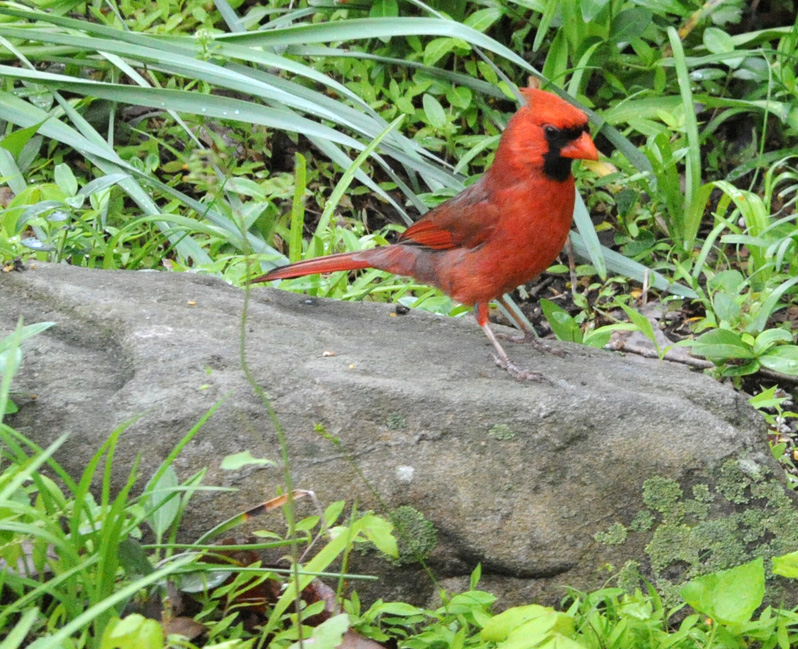
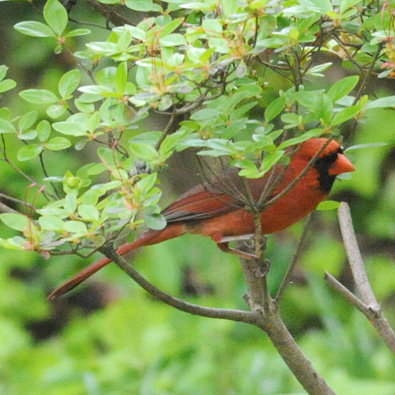 | 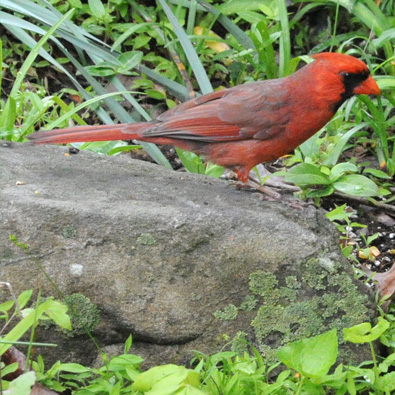 |
The bird population on April 24 was remarkable. We got to see both male and female grosbeaks, which we rarely see, and we saw five indigo buntings, which we have never seen in our yard before!
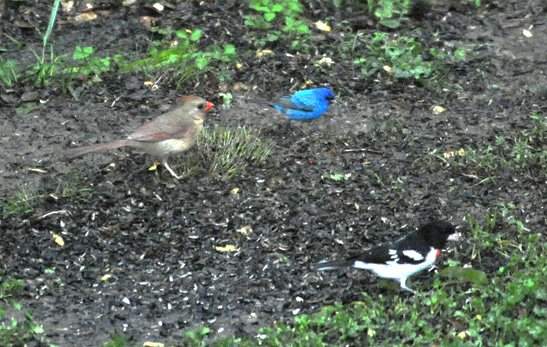 | Welcome to the indigo bunting!We had enjoyed the views of the rose breasted grosbeak and were tracking him around the yard when we saw this flash of blue at the back feeders. We had to look it up because we had never seen an indigo bunting. Even though the resolution is not good, it was a treat to get the female cardinal, the indigo bunting, and the male rose-breasted grosbeak together in one frame. |
We got a good look at the female grosbeak on the platform feeder, the only time we got to see her. This one was apparently a mature one, and the one we saw in 2016 was probably an immature one. 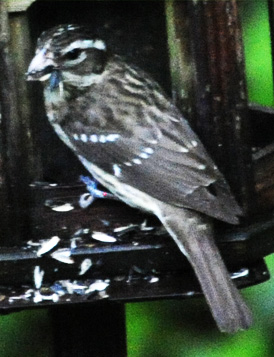 It looks like she is well designed to stay camoflaged on the next while the flashy male diverts everyone. | 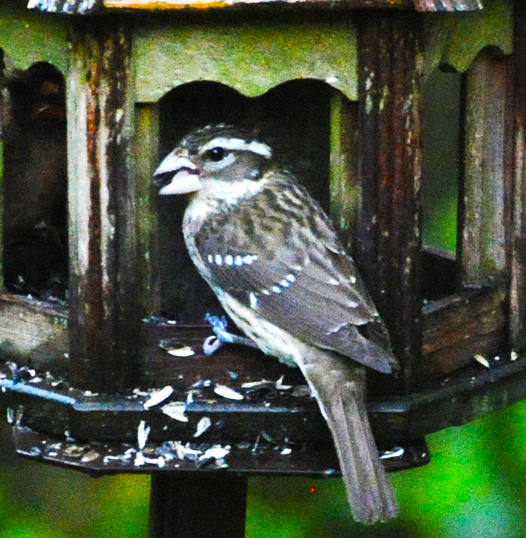 |
A few minutes later we looked down and there were three of the indigo buntings! | 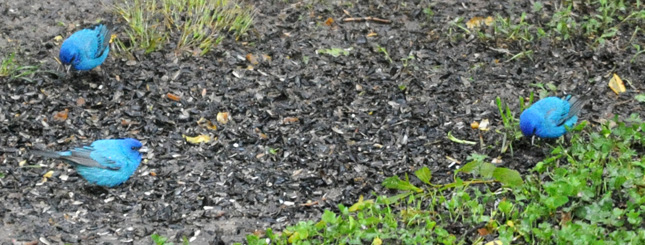 |
 | The next time I looked there were four of them! |
The indigo buntings have a clear preference for ground feeding as does the lady cardinal. She joins them among the black sunflower seed litter beneath our big feeder in the back yard. | 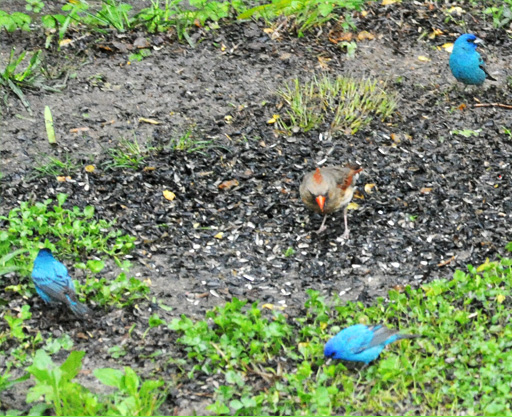 |
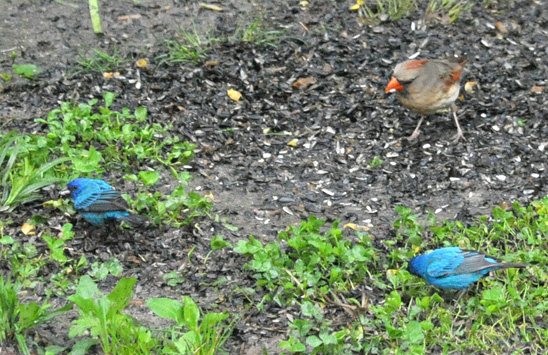 | Watching the lady cardinal and the indigo buntings was a rare treat for our breakfast birdwatching. We actually saw five indigo buntings together at one time, but I didn't get a good shot. |
This fine specimen of the male rose-breasted grosbeak visited with us for several days. He liked both the suet and the black sunflower seed. | 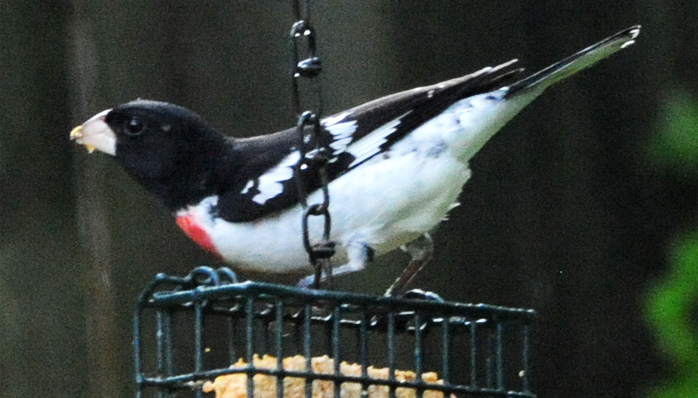 |
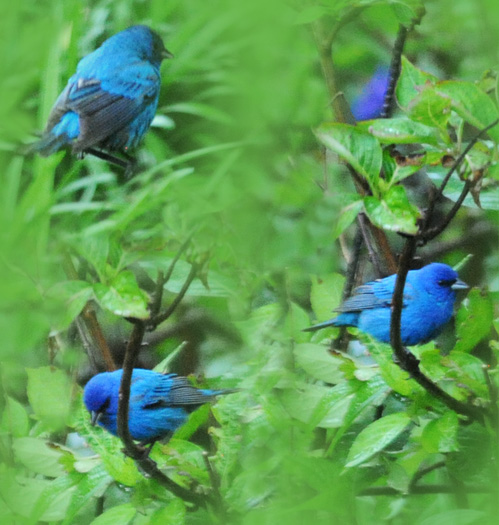 | The indigo buntings were wary and preferred to stick to the back feeders. These are the closest views we got when this one briefly came to the upper feeders. The color is dramatic, and I found it interesting to compare it to the color of the spiderwort bloom you can see in the background.  |
| The grosbeak was definitely not wary. He came back repeatedly and seemed quite at home. | 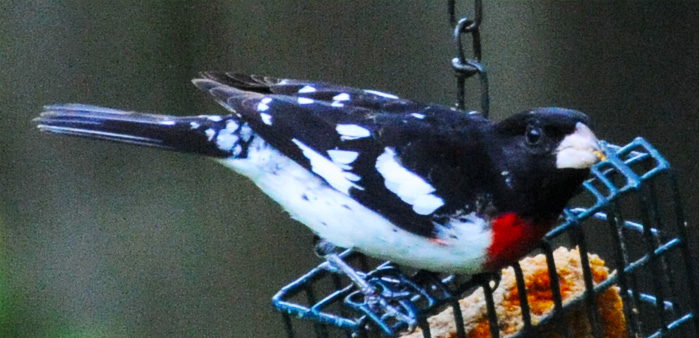 |
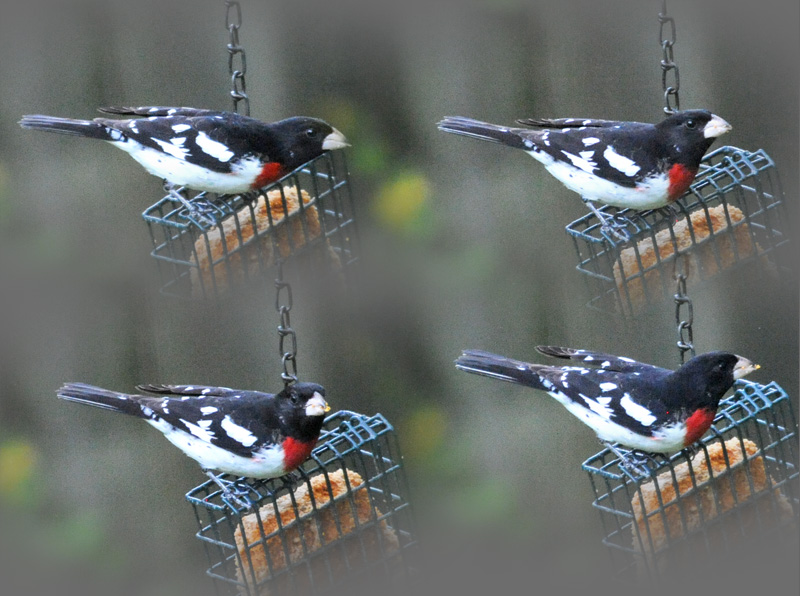
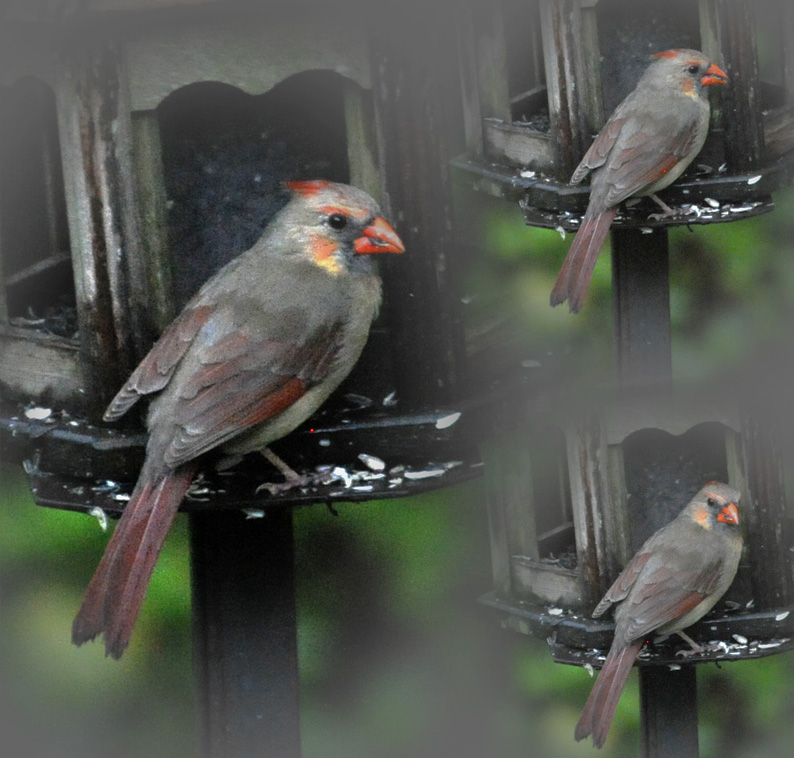
The lady cardinal enjoys some sunflower seed. The next best thing to their favorite ground feeding is this platform feeder.
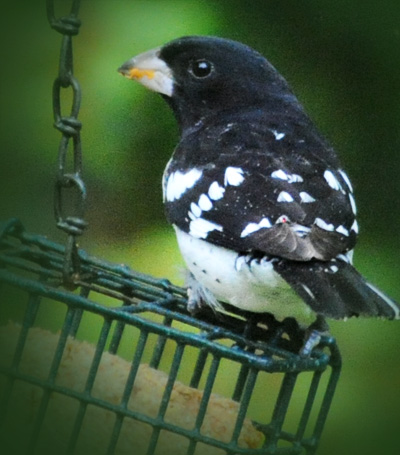 | The grosbeak soon returned to the suet. |
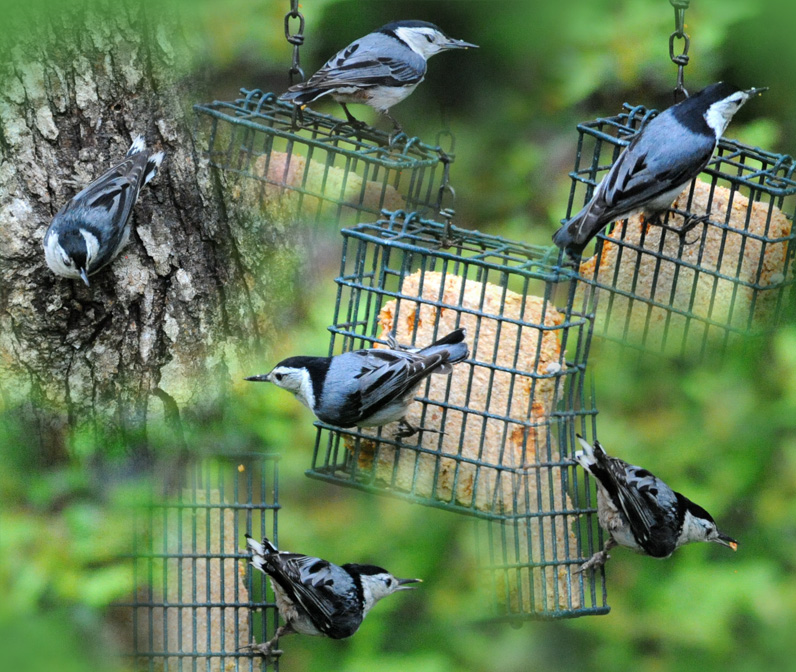
The nuthatch is one of our old friends and certainly one of my favorites. The suet is his favorite food and rare is the day we don't see a nuthatch on this open suet feeder. He has a distinctive cheerful call and is pretty bold, often coming to the feeder when I am just a few feet away. He flares his wings out in an agressive maneuver when a competing small bird approaches.
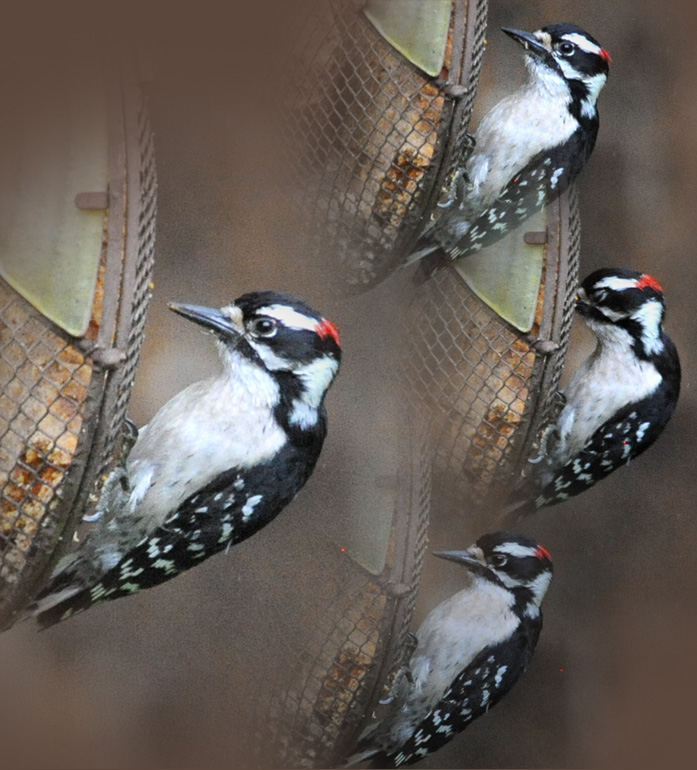 | The downy woodpecker is also one of our old friends whom we see at the suet feeder almost every day. |
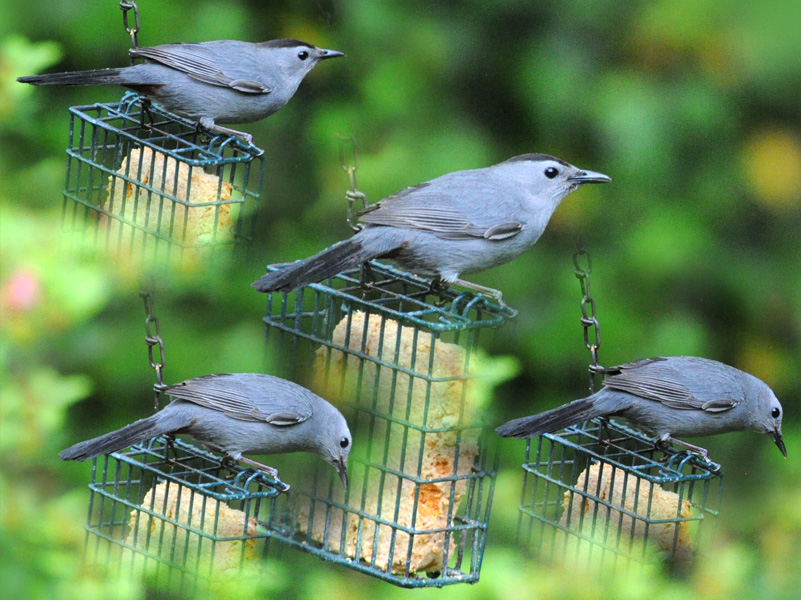
A catbird pair became regular visitors just last year, and they arrived this year early in April. They are some of the most regular visitors and we enjoy seeing the pair together often. I don't have a good auditory memory for identifying bird songs, but their approximate "meowr" easily identifies them as catbirds!
This is a long-distance shot to the back suet feeder and not great in resolution, but it does a good job of showing you what the rose-breasted grosbeak is like. When he moves about, that rose breast really flashes. | 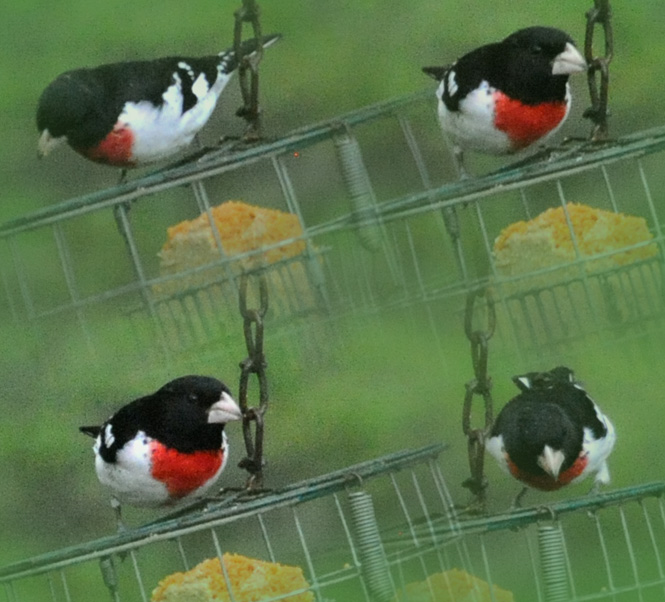 |
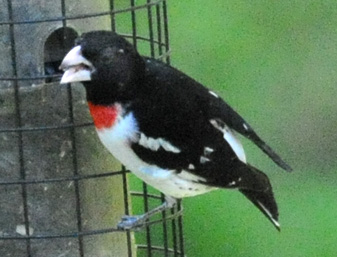 | 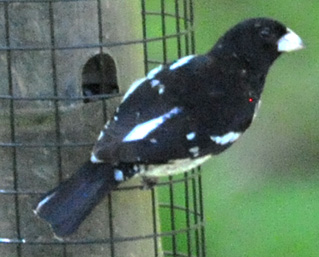 | On April 27 the grosbeak was back, acting like he felt right at home. This time he chose the largest front seed feeder. |
| April 28 and the grosbeak is back early, having chosen his favorite spot. | 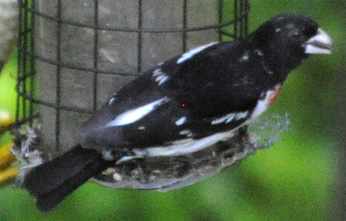 | 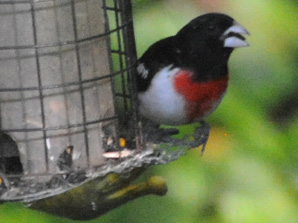 |
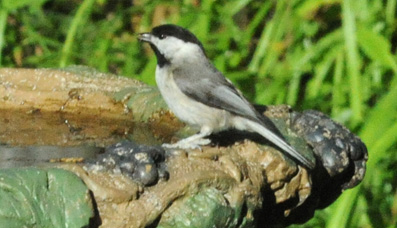 | We are quite fond of the spirited chickadees, who manage to get food and water even though they are small and very low on the pecking order.  |
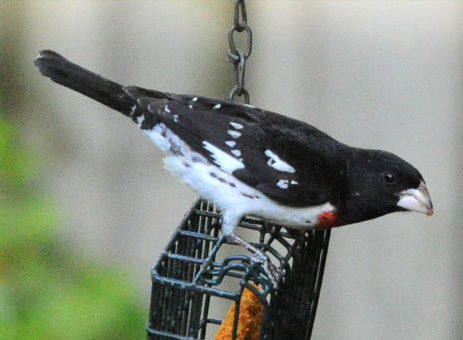 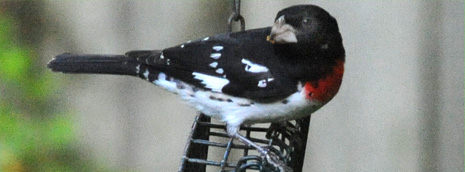 The grosbeak returns to the front suet feeder, and at least I am more hospitable this time, with plenty of food for him. | 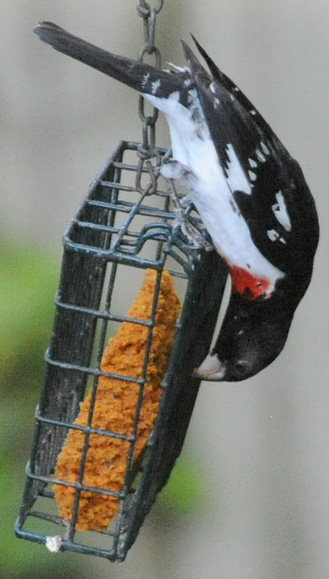 |
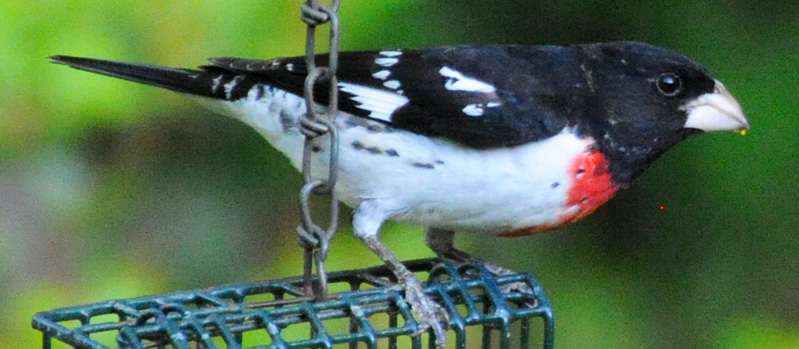
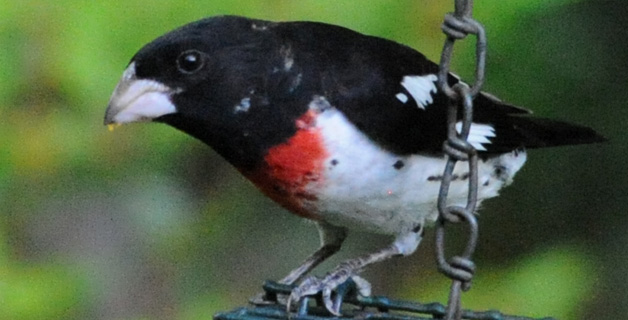 | With good afternoon sunshine, I was able to get a little higher resolution shots of the rose-breasted grosbeak. |
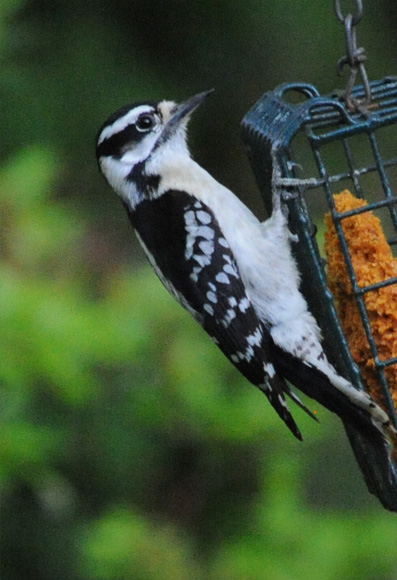 | The downy woodpecker, one of my favorites, is a daily visitor to the suet. This is a female, I believe, without the red head spot. 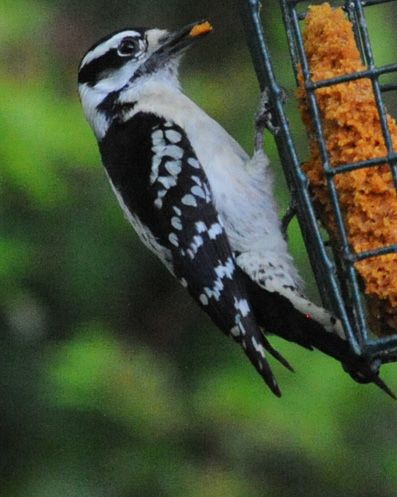 |
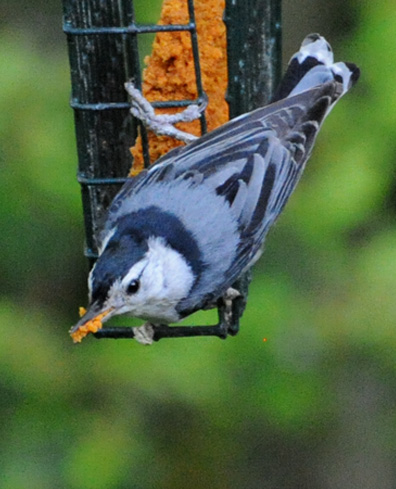 The nuthatch is also an old friend and favorite, and also a daily visitor to the suet. It is an amazing bird, whose feet seem to be able to allow him to be comfortable on a tree trunk either head up or upside down. It seems to prefer upside-down. I love its spirited call. | 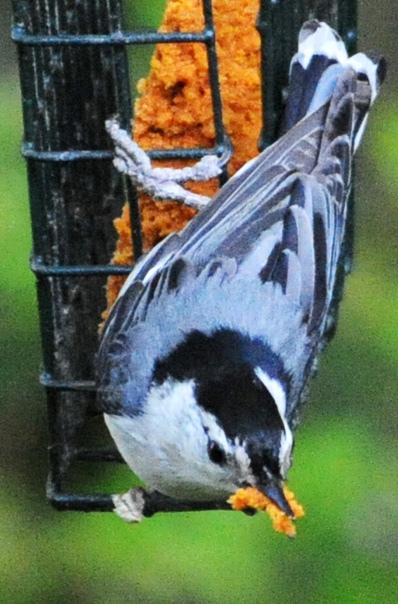 |
April 29 By this time the grosbeak seemed to feel right at home and made the most visits to this sunflower seed feeder. You would get the idea that he was going to settle in for the summer with us, but past experience and the descriptions of Robin Ford led us to expect that we were on borrowed time with him.
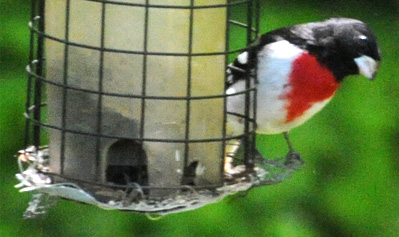 | 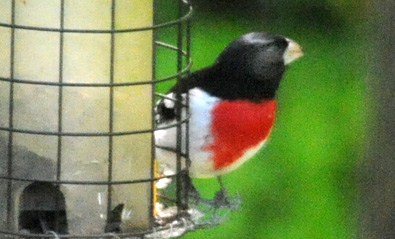 |
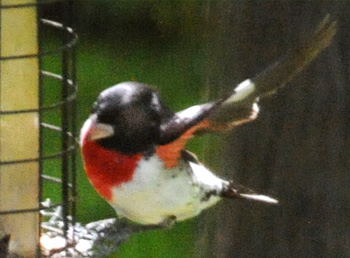 | Once again we got a flash view of his wing which revealed the otherwise hidden splash of color there. He made a few visits to the platform feeder, but seemed to prefer the seed feeder. | 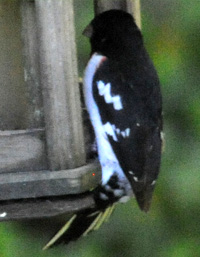 |
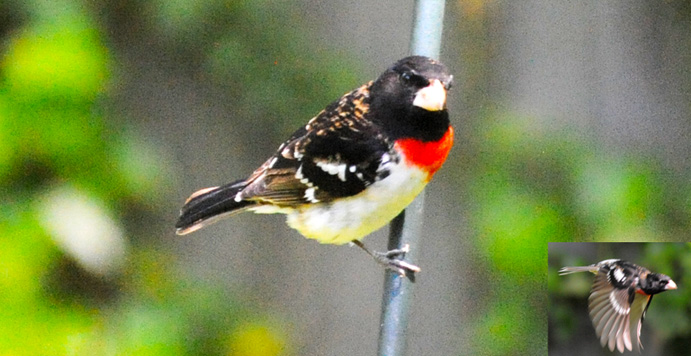 | When Mr. Grosbeak came to pose on one of the poles and looked at us, I took that to be his goodbye gesture, since our expectation was that he would soon continue his northward migration. It turned out that we saw him one more day, but we took it as a nice gesture. |
April 30 This was our day of bidding farewell to the rose-breasted grosbeak for this year. We continued to enjoy the lively catbird pair.
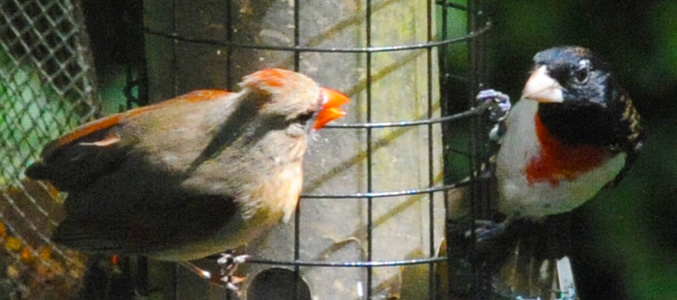 | Looks like a conversation between the female cardinal and the male rose-breasted grosbeak. Maybe he's saying goodbye until next year. Anyway, this was the last time we saw the grosbeak. We saw him first on April 23, so he spent a week with us this year. |
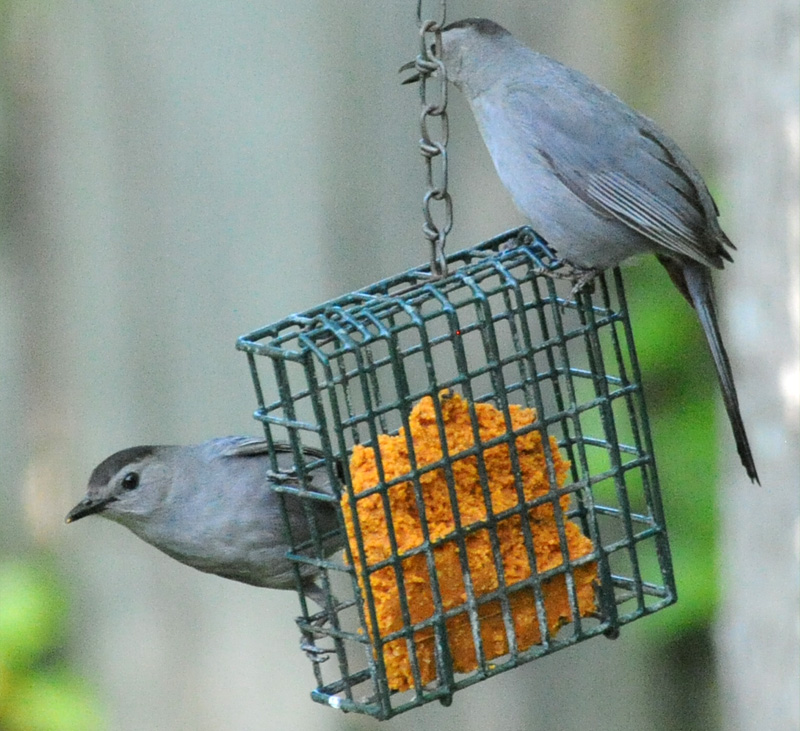
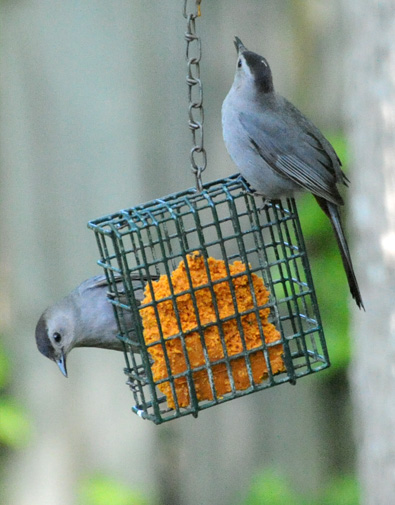 | 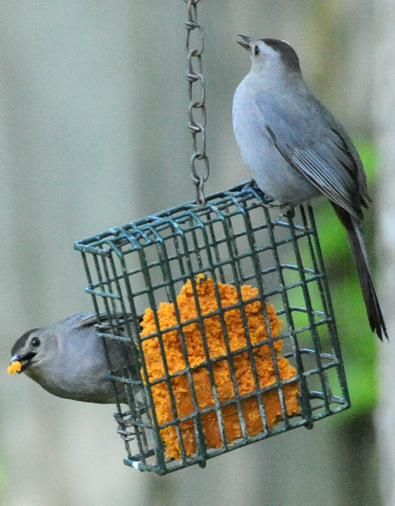 |
The lively catbird pair enjoyed the suet, and we enjoyed watching them.
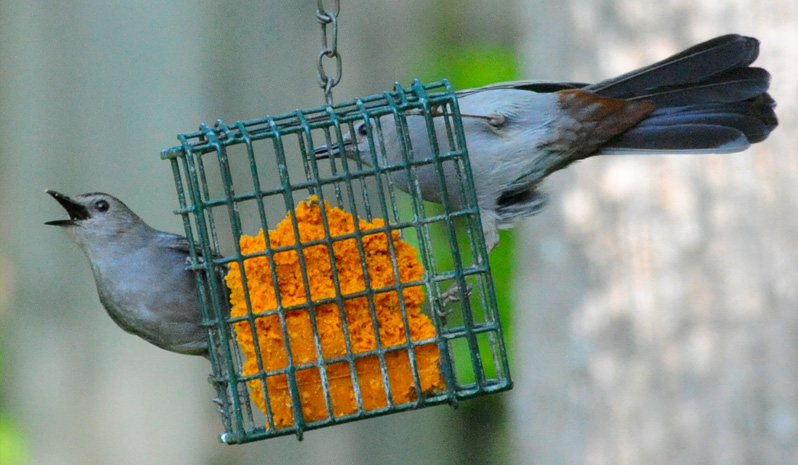
At times the catbird couple's behavior approached the flamboyant, like a Spanish flamenco dance. One time they were doing an aerial dance together in the air above the feeder, like a courtship ritual.
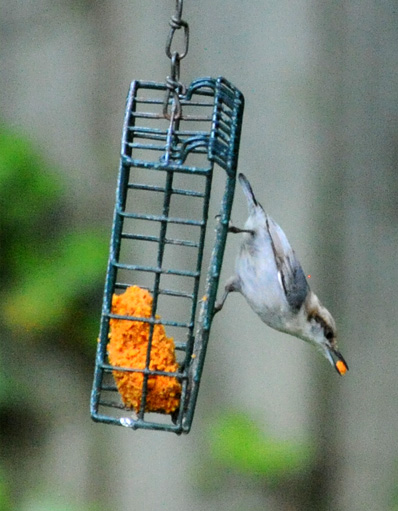 | 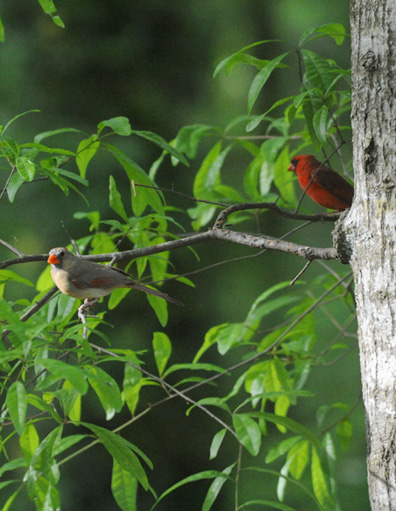 |
On May 1 we got our first view of the tiny brown-headed nuthatch this year. On May 2 we got this interesting view of the female and male cardinal, but they definitely don't hang around together like the catbird pair does. We have had a very enjoyable time at the breakfast table each morning, watching the birds that come to feed.
| Spring activities |
2018